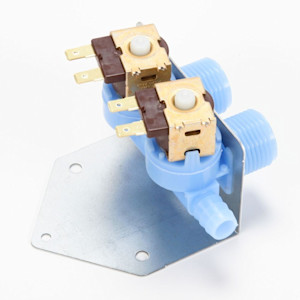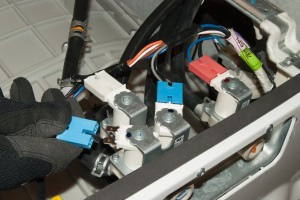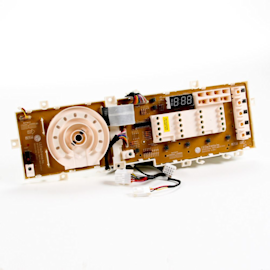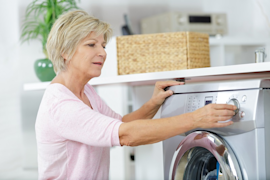How to replace a water inlet valve on a front-load washer

This step-by-step washer repair guide shows how to replace the water inlet valve assembly on a front-load washer. Replace the inlet water valve with a manufacturer-approved washer part if your washing machine doesn't fill or if it fills with water even when the washer is unplugged.
This procedure covers water inlet valve assembly replacement in Kenmore, LG, Whirlpool, Frigidaire, GE, Maytag, Amana, Samsung and Bosch front-load washers.
We also have instructions for replacing the water inlet valve on a vertical modular top-load washer and replacing the water inlet valve on a direct-drive top-load washer.
This video shows how to replace the water inlet valve on a front-load washing machine.
Instructions
- 01.
Shut off the electricity and water
Unplug the power cord from the wall outlet.
Enlist an assistant to help pull the washer away from the wall.
Turn off the water supply valves for the washer. Wear work gloves.
- 02.
Disconnect the fill hoses
Mark which fill hose goes to the hot connector and which goes to the cold before removing.
Using channel lock pliers, carefully loosen and remove both hoses.
Expect some water to pour out.
Tip: Wipe up water spills with a towel to prevent slipping.
PHOTO: Disconnect the fill hoses.
- 03.
Remove the top panel
Move the washer so can you can work behind it.
Using a Phillips screwdriver, remove the 2 screws on the back of the washer that hold the top panel.
Pull the top panel toward the rear of the washer and lift it up and off.

PHOTO: Remove the top panel screws at the back of the washer.

PHOTO: Remove the top panel.
- 04.
Remove the water inlet valve assembly
Take a picture of the wiring connections or label them so you can reattach them correctly.
Carefully pull the wires from the water inlet valve assembly; use needle-nose pliers if needed.
Take care to not damage the connectors.
Take a digital picture of the hoses or label them so you can reattach them correctly.
Release the spring hose clamps and pull the hoses off the inlet water valve assembly.
Holding the inlet water valve assembly to keep it from dropping into the washer cabinet, use a Phillips screwdriver to remove the 2 mounting screws.
Remove the valve assembly.

PHOTO: Pull off the water inlet valve wires.

PHOTO: Pull the hoses off the water inlet valve.

PHOTO: Remove the water inlet valve mounting screws.
- 05.
Install the new water valve assembly
Position the new water inlet valve assembly, lining up the holes for the mounting screws.
Reinstall the mounting screws.
Avoid overtightening by turning the screws until they stop. Then give the screws one firm twist so they’re snug in place.
Using your photo or labels to determine placement, push each water line onto its correct connection.
Secure each line with its spring clamp. Using your photo or labels to determine placement, push each wire connector fully onto its connector spade.

PHOTO: Reinstall the hoses on the valve.

PHOTO: Reconnect the wires to the inlet valve.
- 06.
Reinstall the top panel
Push the panel down and forward to seat it on the washer frame.
Reinstall the screws to secure the back panel. Avoid overtightening.

PHOTO: Reinstall the top panel.

PHOTO: Reinstall the top panel rear bracket screws.
- 07.
Reinstall the fill hoses
Thread the fill hoses onto the connections on the back of the washer, checking that hot and cold lines are in the correct place.
Tighten the connections firmly using channel lock pliers. Don't overtighten because that can crack the plastic in the valve.

PHOTO: Reconnect the fill hoses to the inlet valve.
- 08.
Restore the water and power
Turn on the water supply valves and check for leaks at the wall and the washer. Tighten the connection if you find a slight leak. Plug the washer into the electrical outlet.
Return the washer to its original location.
Most common symptoms to help you fix your washers
Choose a symptom to see related washer repairs.
Main causes: clogged drain hose, house drain clogged, bad drain pump, water-level pressure switch failure, bad control b…
Main causes: worn agitator dogs, bad clutch, broken motor coupler, shifter assembly failure, broken door lock, suspensio…
Main causes: bad lid switch or door lock, bad timer or electronic control board, wiring failure, bad water inlet valve a…
Main causes: broken lid switch or lid lock, bad pressure switch, broken shifter assembly, faulty control system…
Main causes: unbalanced load, loose spanner nut, worn drive block, broken shock absorber or suspension spring, debris in…
Main causes: no water supply, bad water valves, water-level pressure switch failure, control system failure, bad door lo…
Main causes: lack of electrical power, wiring failure, bad power cord, electronic control board failure, bad user interf…
Main causes: leaky water inlet valve, faulty water-level pressure switch, bad electronic control board…
Main causes: water heater failure, bad water temperature switch, faulty control board, bad water valve, faulty water tem…
Repair guides for front-load washers

How to replace the door boot on a front-load washer
If your washer leaks from under the door panel, replace the rubber door boot if it's torn.…

How to replace the user interface board in a front-load washer
Follow these steps to replace the user interface board in your front-load washer if the buttons or lights are broken.…

How to replace the drain pump on a front-load washer
Follow these steps to replace the drain pump if it's not removing water from the washer.…
Effective articles & videos to help repair your washers
Use the advice and tips in these articles and videos to get the most out of your washer.

Find tips for using your washing machine efficiently to save energy and help reduce utility bills.…

Learn about all the convenient features on our Sears PartsDirect website that make your parts purchases easier.…

Get answers to frequently asked questions about Sears and Sears PartsDirect.…
